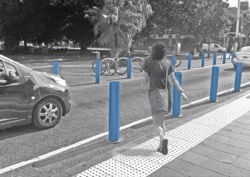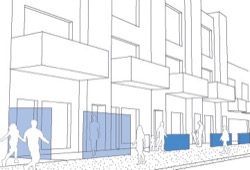On this page:
Importance of barriers and fences in urban design
Barriers such as bollards and fences can define boundaries and protect people from traffic hazards and level changes. They also protect trees and shrubs from people and vehicles.
A barrier may be made as bollards, screens, rails, fences, kerbs and walls. Barriers and fences can provide an opportunity for public art or to communicate local stories. They may also provide opportunities for seating.
6.4.1: ensure barriers and fences support amenity and safety
- Locate bollards to allow free pedestrian movement, while controlling vehicle access to an area.

Tip: use bollards where the purpose is to filter movement modes. Bollards may be removable or permanent. Bollards are preferable to continuous a fence or barrier, as they allow choice of movement for pedestrians and cyclists, while limiting vehicle access. - Position bollards to be highly visible to pedestrians, drivers and cyclists and of a height to avoid injury.
Tip: bollards should not be used in place of hazard markers. Use specific hazard marker signs.
- Use highly visible barrier materials for both day and night visibility.
Tip: people with vision impairment must also be able to detect barriers. Tactile ground surface indicators may also be needed.
- Set back cafe screens or barriers an optimal 800 mm (minimum 500 mm) from the kerb, leaving a 3000 mm clear path (minimum 1500 mm).
Tip: cafe screens can define a street cafe area, protect customers from wind and provide psychological protection from vehicle traffic, but they can also block pedestrian movement on a footpath. Screens may be fixed in position or movable.
- Provide barriers and fences with a non-injurious top rail detail.
Tip: low level fences with pointed prongs are a hazard and have resulted in accidental injuries.
6.4.2: ensure that barriers and fences contribute to the character of the area
- Use a style, scale and materials for barriers that contribute to the existing or desired future character of an area.
Tip: front fences can be a strong visual element, especially in higher density residential precincts, and contribute significantly to the character of the street.
6.4.3: ensure front fences support informal surveillance to the street and public spaces
- On a property boundary abutting a street frontage or public space, use fence types that are low height or partially transparent.

Tip: low or transparent fences provide opportunities for informal surveillance of streets and public spaces.
Page last updated: 09/06/23